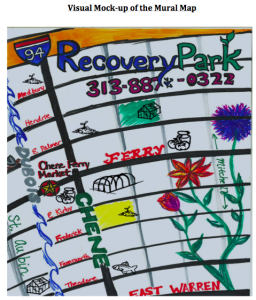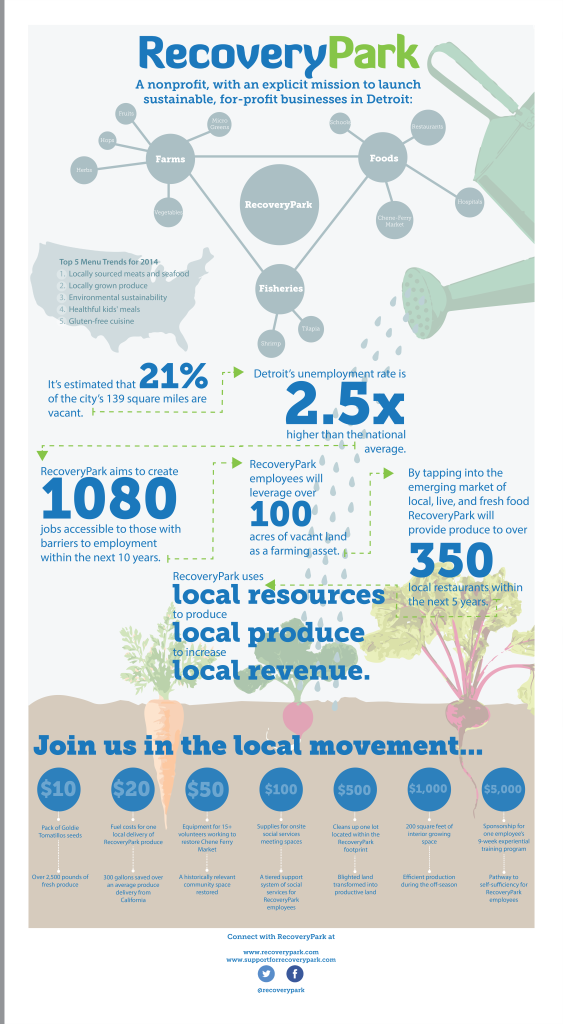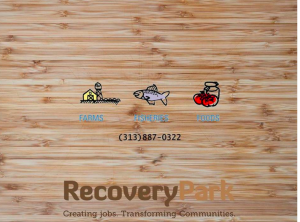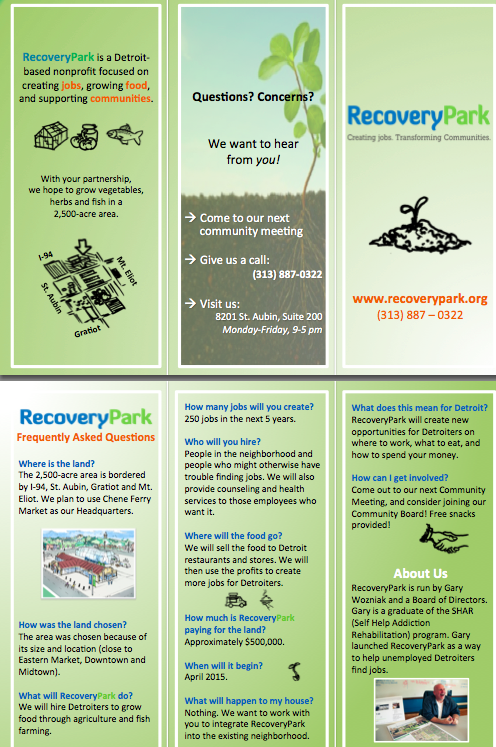By: Annie Hakim
RecoveryPark is non-profit organization dedicated to creating jobs for Detroiters with barriers to employment (low literacy levels, recovering addicts, returning citizens). By converting blighted land into urban agriculture and aquaculture ventures and growing a family of value-added food production businesses, RecoveryPark plans to create over 1,000 jobs, over the next ten years, which will help grow Detroit’s ‘local-live-fresh’ food movement. For five Fridays (from Sept. 26-Oct 24) Challenge Detroit Fellows worked with RecoveryPark on their first ‘Social Impact Challenge‘ of the year.
Currently, RecoveryPark is in the final stages of land acquisition (110 acres surrounding Detroit’s historic Chene-Ferry Market) from the City of Detroit. As this draws to a close, reengaging the community in and around the RecoveryPark ‘footprint’ (the acquired land) is critical.
“Many projects never achieve their true potential because they fail to immerse themselves in the communities they are in. Importantly, a major RecoveryPark goal is establishing community members as partners, rather than spectators.”
-Gary Wozniak, RecoveryPark President and CEO
The project design question posed by RecoveryPark for the Challenge Detroit fellows to tackle:
How might we use different mediums to creatively communicate the mission and vision of RecoveryPark, and strategize for the coordination of future stakeholder (community members, businesses, city partners, non-profit partners etc.) engagement?
For the Challenge, the fellows broke into nine teams; each with unique and multifaceted objectives and deliverables designed to achieve RecoveryPark’s overarching goals for the project:
- Engage an otherwise disenfranchised and fragmented community in RecoveryPark development initiatives
- Creatively capture and publish their input
- Develop collateral pieces (graphics, info-graphics, videos, pamphlets etc.) that tell RecoveryPark’s story in the community context
- Design an engaging social media strategy to establish the digital identity of RecoveryPark
- Utilize the data to drive project design
The Nine Challenge Teams:
Local-Live-Fresh Video Team
Courtney Hardebeck, Ifeanyi Nwachukwu, Bethany Felder, Jason Aoraha
RecoveryPark is hoping to play an integral role in the continued development and promotion of the Local-Live-Fresh food movement in Detroit. This short video created by a team of four fellows, features two admirable players in greater Detroit’s ‘Buy Local’ efforts and makes a compelling case for the importance of understanding and contributing to local food systems.
Special thanks to the interviewees in the video:
Chef James Rigato: The Root Restaurant, owner and 2014 Top Chef Contestant
Michelle Lutz: RecoveryPark Farms, Manager
Graphics Team
Sarah Robb, Benjamin Breuninger, Elizabeth Grabowski, Ann Phillips
After coordinating and brainstorming with a number of stakeholders:
Joshua Smith- RecoveryPark’s resident graphic designer
Professor Joongsub Kim (and his students) RecoveryPark Urban Planning
Michelle Lutz- RecoveryPark Farms Manager
Mike Berger- RecoveryPark Farms Support
The team worked to imagine and create graphics (linked below) that communicate the possibilities and scope of RecoveryPark’s development of their footprint.
*These graphics are strictly ideas of what the footprint could look like in the future- they do not represent concrete development plans.
–Current Aerial View of the RecoveryPark Footprint (showing where it is in the city of Detroit)
–Current state of the blighted lots in the Footprint
-Imagining the Footprint after RecoveryPark development 2017
–Dubois Street currently (which runs through the Footprint) 2014
–Dubois Street in 2016 (after the installment of a GLRI storm water management swale, which RecoveryPark will use to harvest water for farming)
–Chene-Ferry Market in 1921 (at the heart of the Footprint-it used to rival Detroit’s Eastern Market)
–Chene-Ferry Market 2014
–What the graphics team imagines Chene-Ferry could look like in 2017
Info-graphic Team
Hannah Mills, Courtney McCall, Seth Haug, Alyssa Brown
After combing through the extensive 24-page RecoveryPark business plan, the info-graphic team worked to convey RecoveryPark’s mission and economic viability model concisely, and visually. Their final product makes a compelling case for RecoveryPark’s multi-faceted and sustainable business model, and will be used by the organization to inspire community engagement as well as encourage philanthropic donations.
Community Engagement Team
Jessica Wang, Ellen Trudell, Carmen Bojanowski
After conducting research on how successful/unsuccessful community engagement and communication strategies have been implemented in blighted areas where residents often do not have access to technology, the community engagement team created an outline of innovative strategies to keep residents in the Footprint involved in and informed about RecoveryPark development efforts. Additionally the team created a RecoveryPark FAQ brochure (pictured below) and Research Summary Piece (A succinct look at RecoveryPark’s urban agriculture initiatives, and how it compares to similar ventures) They also re-imagined ways to deliver door-to-door information to residents. (In the past RecoveryPark has used postcards and door hangers to inform residents, but it hasn’t been effective.)
Their innovative collateral ideas:
A RecoveryPark cutting board, a RecoveryPark vegetable peeler, and an interactive mural, painted on the side of Chene-Ferry market, that maps out the footprint and is partly painted with chalkboard paint so that the RecoveryPark team can update the residents on where and when development projects will take place.

“Our team is proud of creating a clear and innovative community involvement strategy that will provide opportunities for neighborhood residents to engage with RecoveryPark and have their voices heard. We know that our ideas and recommendations will be seriously considered by RecoveryPark (and hopefully implemented!).”
-Jessica Wang, Community Engagement Team Lead
Social Media Strategy Team
Alison Figliomeni, Amanda Gettgen
The social media strategy team did an incredible job creating a social media identity for RecoveryPark that innovatively and consistently reinforces the mission and vision of the organization. The team did a lot more than just overhauling RecoveryPark’s Facebook and Twitter pages. They wrote an extensive report complete with analytics of RecoveryPark’s current presence on Facebook and Twitter, strategic goals for usage of the organization’s social media outlets with corresponding performance indicators, and an outline for a ‘viral’ campaign that will enable RecoveryPark to help encourage and facilitate the buzzing conversation around the local-live-fresh food movement in Detroit. By utilizing Hootsuite the team also generated and scheduled over a month of content that will help to reintroduce and reconnect the organization to its digital audience.
“I feel like with marketing, social media, design, etc. today it seems rather difficult to really stand out and truly be unique. I feel as though [our work] really will set RecoveryPark aside from other organizations–both alike and different.”
-Alison Figliomeni, Social Media Team Lead
Listening Tour (with a Focus on Community Anchors) Team
Jonathan Ganci, Kristina Wilson, Zeke Harris, Jennifer Ehrhardt
By conducting several interviews with community anchors (residents, businesses owners, church leaders, school principals, non-profits leaders etc.) in and around the RecoveryPark footprint, and transcribing and analyzing the interviewee responses, the team gathered some invaluable insight. In any given urban development project, success is dependent upon understanding the perspectives, ideas and goals of key stakeholders in the community. There is a huge difference between doing a project for a community, and doing a project with the community- RecoveryPark is striving for the latter. After concluding all of their interviews, the group made a simple but insightful recommendation to RecoveryPark about how to best work with the community: In the process of developing the footprint, be inclusive, empathetic, authentic and transparent.
A few quotes from their interviews:
Q1. What are your thoughts on urban farming coming to this area?
A.“This is potential, this is an untapped, completely untapped, unthought-of situation here in Detroit and you’ve got the perfect place.”
-John Gibbons, Community Member 45+years
A.“A lot of people view farming as pretty cool. A lot of people came from the South and were farmers and when you do farming around here it really resonates a chord with a lot of people in the community because it’s all about self-sustainability. It’s about working the land. It’s environmental. It’s about learning to respect the place you live in, beautification, it works on all levels.”
-Anonymous community member
Q2. What do you think about someone coming in and developing the land?
A. “The problem with the East side is, I wouldn’t really say haters, but doubters. And I think that’s across the board with a lot of people. The reasons are very different but the attitude is the same. We’re just cautious of people who have big plans and don’t really have boots on the ground. Why don’t you put boots on the ground, and then we’ll talk.”
-Anonymous community member
Team 8: Listening Tour (with a focus on food related businesses)
Nicholas Prys, Liz Venatta, Brittany Stallworth, Brandon Bufford
RecoveryPark Farms is the first of the family of the for-profit food related businesses RecoveryPark will launch to train and hire Detroiters with barriers to employment. Although RecoveryPark has not yet begun to develop its Footprint, RecoveryPark Farms currently manages a pilot project (1 hoop house) that grows the variety of specialty produce that will eventually be grown on a much larger scale in the RecoveryPark footprint. By doing so, they’ve generated a demand for their product from a number of top restaurants in Detroit. (The Root, Bacco Ristorante, Cuisine, The Stand Gastro-Bistro, Wright and Company, Torino, Stockyard Detroit).
With the help of the RecoveryPark Farms manager, Michelle Lutz, the listening tour team wrote a series of interview questions designed to gauge how owners, chefs, and investors from metro-Detroit restaurants (Al’s Café, Cafe Cortina, Fountain Bistro, La Dolce Vita, Vince’s, The Whitney) and grocery stores (Busch’s, Mazen Grocery Store, Trader Joe’s) see themselves fitting into the ‘local-live-fresh’ food movement in Detroit. RecoveryPark Farms will reference the interviewee responses, transcribed and analyzed by the team of fellows, as they work to continue growing their client base in the city.
The team discovered a few important common trends in the responses they received:
-Every business that they interviewed was both interested and invested in buying (at least some) local produce- so long as the product quality is consistent and the prices are competitive.
-Currently, buying locally year-round isn’t an option for them because Michigan’s growing season only lasts about nine months.
“We like to use Detroit based companies [but] in the wintertime, you have to be happy with where you can get it, because sometimes it’s a matter of not finding it. And your lettuce comes from California, so there’s nothing you can do about that.”
-Owner of Vince’s Italian Restaurant- Detroit
It’s exciting to know that RecoveryPark Farms, once fully built out with greenhouses for year round growing, will be able to meet a currently un-met demand for locally grown produce during the winter months- so long as they can keep their prices competitive.
RecoveryPark Spring Opener Team
Martha Cavazos, Anna Schroen, Jazmyn Becker, Kenny Andejeski
Before launching their first development projects in the Footprint, RecoveryPark plans to host a weeklong ‘groundbreaking’ event designed to:
-Make a positive statement in the neighborhood by fostering collaboration between community members, volunteers, and RecoveryPark’s team and funders (100+ volunteers per day)
-Cleanup blighted land in the RecoveryPark footprint.
The team created an extensive strategic plan for the planning, marketing, and coordination of the weeklong volunteer cleanup efforts. The five major pillars of their plan are thoughtful, intentional and innovative:
-Re//consider: The event can be more than a typical volunteer blight cleanup
-Re//invent: Incorporate local food, workshops, and celebration
-Re//late: Multiple types of participants (footprint residents and corporate and community volunteer groups) will work alongside each other
-Re//claim: Turn remaining blighted structures into canvases for interactive community art
-Re//peat: Make the event the first of many- designed to sustain and grow relationships established amongst volunteers, community members and the RecoveryPark team.
Additionally, the team connected with several organizations (Woodward Throwbacks, Detroit Boxing Gym, Triumph Church, Historic Trinity Lutheran Church, Wayne State Student Urban Planners, DTE, Chrysler Motor Citizens Program, Quicken Loans, and Compuware), and secured over 600 volunteers that are slated to participate in the May event.
RecoveryPark Footprint/Site Assessment Team
Hayden McNeil, Rachel Rosenbaum, Alissa Sevrioukova, Larry Latimore
Tasked with conducting a site assessment of the RecoveryPark Footprint, the team worked to determine the man-power and resources necessary to facilitate the community/volunteer cleanup event. As part of a detailed report outlining a strategy for the site cleanup, the team created multiple graphics portraying/mapping the current state of the land, as well as acomprehensive info-graphic designed to ensure volunteer safety. Team lead Hayden McNeil commented on his team’s efforts to ensure a safe and efficient approach for the site cleanup:
“Our team reached out to [the Detroit organization] Blight Busters very early in the process and fostered a great relationship with them. We were essentially consultants between Blight Busters and Recovery Park and it seems as if the two are moving towards a partnership in the future. If this is the case, we made a significant impact. Even if the partnership is not achieved, many of our fellows have made solid ties with the representatives from Blight Busters and have/will volunteer with them in the future. Our team most enjoyed working with other agencies such as Blight Busters, Sit On it Detroit, and Life Remodeled as we began to figure out our role. I believe we all feel more connected with the city as we were in constant contact with agencies that really make the city thrive.”
-Click here to view maps and graphics created by the Site Assessment Team
Project Wrap-up
At the end of the five week project all of the teams presented their work to over 100 people; leaders in Detroit’s public, private and non-profit sectors, Detroit residents, friends and family members.
“RecoveryPark couldn’t be happier with the deliverables created by the different teams. The Challenge Detroit fellows creatively translated our mission into a video, graphics, social media, and community engagement strategies and collateral. Their attention to detail, receptiveness to feedback, and enthusiasm was impressive and inspiring. RecoveryPark and the city of Detroit are fortunate to have such a passionate, intelligent and talented group of young professionals invested in being part of the continued development of our community.”
– Gary Wozniak, RecoveryPark President and CEO
——-
***Special thanks to the people that played an integral role in the development and success of the Challenge Detroit/RecoveryPark Social Impact Challenge: Gary Wozniak, George Gardiner, Michelle Lutz, Mike Berger, Michael Thomas, Joshua Smith, Chris Grindem, Charlie Poat, Steve Sajewski, Karen Dumas, Professor Joongsub Kim, Charlie Wilson, Khalil Ligon, Chef James Rigato, Russ Russell, John George, Sarms Jabra, Shelley Danner, and Deirdre Greene-Groves




